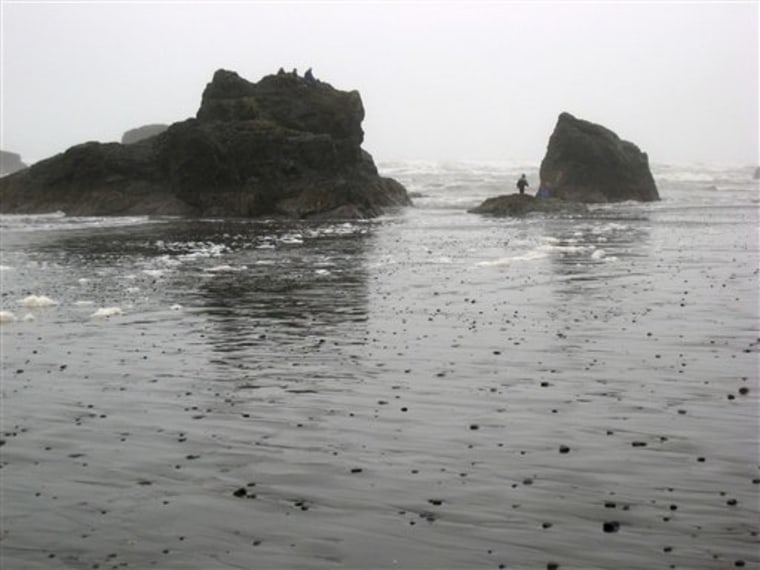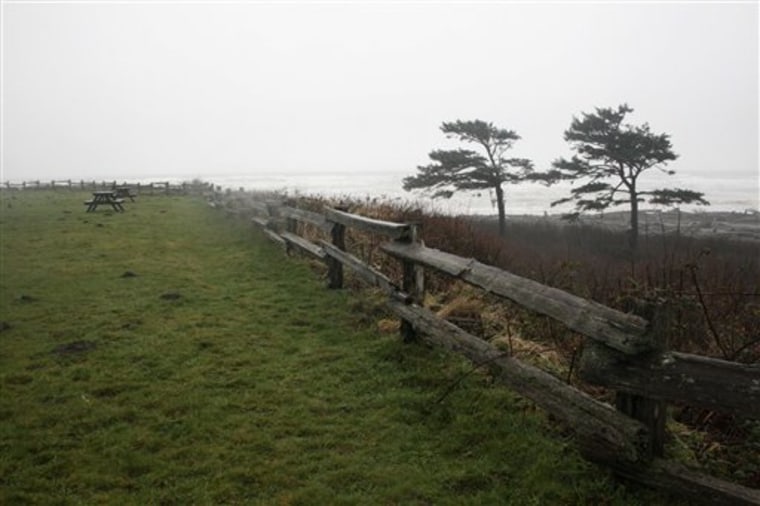The weekend forecast: low 50s with a 79 percent chance of showers for both days. My first thought: perfect.
Sunny skies thwarted my last attempt to visit Kalaloch Lodge, which bills itself as a winter storm-watching destination on Washington's Olympic Peninsula from mid-October through mid-March. This time, nothing would stop me from trading Seattle's persistent drizzle for the coast's more dramatic clime.
I crammed a bag with "performance" garments, a section of my closet that has grown exponentially since I moved to the Northwest from New York four years ago, and which now includes fleece jackets, a down vest, base layers of varying weights, wool socks, hats, waterproof hiking shoes and a rain shell. My roommate did the same, and we hit the road with directions and smart phones in hand and our two dogs in the back seat. Most of Olympic National Park is off-limits to dogs, but the lodge and nearby beaches permit them on leash.
Many local names have roots in Native American languages, giving us the opportunity to play several rounds of "how do you pronounce this town" during the 3 ½-hour drive. This edition included Puyallup (pyoo-AL-up), Hoquiam (HOE-kwee-uhm), Queets (KWEETS), Humptulips (exactly like it looks), Quinault (kwin-AWLT) and our final destination, Kalaloch (CLAY-lock).
Kalaloch Lodge is a salty, shingled two-story affair that sits right alongside Highway 101. Behind the back deck, the land falls off sharply to where the muddy Kalaloch Creek runs into the Pacific. On this rainy Saturday, the sky, ocean, and beach stacked up in layers of pale browns and grays, with misty evergreen silhouettes framing our view.

The lodge itself has a handful of rooms, but most guests stay in one of the cabins lined up on a cliff facing the ocean. None have Internet, television or phones. The "Bluff Cabins" are closest to the edge and have large windows with unobstructed views of the surf. Ours — a small wood-paneled studio with a queen-sized bed, a futon and a kitchenette — gave me a jolt of summer-camp nostalgia. The tiled floor was a smart, anxiety-free touch for travelers with damp, sandy dogs but made me wish I had packed cozy rubber-soled slippers.
On Saturday, a dog-loving employee at the front desk directed us to the more deserted stretch of beach — a short walk north on the side of Highway 101, then left into the woods on a gentle hiking path. Getting onto the beach required scrambling over and ducking under the slippery, bleached-out tree trunks piled up just past the tree line.
We tromped through spitting rain and hand-numbing cold for almost an hour, making me wish I had remembered rain pants along with the rain jacket. A couple and their dog appeared in the distance but turned back long before we reached them. The afternoon's gloom made the occasional car headlights, colored stone or reddish log practically glow neon. We marveled at the people hardy enough to pitch tents at campsites just inside the trees.
We did not, however, see any evidence that a storm was coming any time soon. The dogs were cold, and we were starving, so we headed back. (Wilderness tip No. 1: Mark the spot where the trail meets the beach. We stumbled around a bit trying to find it.)
At the lodge restaurant, we scarfed down cups of thick New England clam chowder (very good, $5.25), and fried fish ($15) and clam strips ($10). We peppered our waitress with questions about nearby attractions and other options for dinner, only to learn that the nearest was Quinault Lodge, another Olympic National Park hotel operated by the same company, 32 miles away. What about Forks, the town best known as the setting for the popular "Twilight" vampire books for teens? Her face twitched a little at the idea that we might drive 36 miles in the opposite direction for a meal there, so we let it drop.
Back in our room, we read and waited for the weather. I tried researching our next move, but neither the Verizon Wireless smart phones nor the AT&T Internet thing for my laptop had any signal. What did people do before the Internet? My guess is they took a lot of naps.
When dark came, it was absolute and there was no sense looking out the windows. We had brought beer and wine and decided to supplement with cheese and crackers from a little general store on the property, instead of sitting down to another heavy meal. I repeated my question about Forks to the store clerk, who looked at me like I had asked if we should walk into the woods and just start eating tree fungus.
At the last minute, I decided to buy a deck of cards at the store, but back at the cabin realized I had completely forgotten how to keep score in Gin Rummy, or how to set up to play Spit, another childhood favorite. What did people do before the Internet? Go to bed early?
At some point in the night, I heard a rumble of thunder. My roommate, a lighter sleeper, reported that the storm stayed in the distance. So much for storm-watching.
Sunday brought a stop at Ruby Beach, a slightly more crowded spot a few miles north of Kalaloch. The quarter-mile path from the parking lot took us through tunnels of branches, some decorated with puffs of bright-green moss. We wandered up the beach, checking out sea stacks, the island-like rocky columns just offshore. (Wilderness tip No. 2: Check the tide chart. Even a few hours after high tide, our walk was limited.)
Out of curiosity, we headed down the nearby "Big Cedar" road. Sure enough, at the end there was a very big cedar tree. Satisfied that we had seen the sights, we hit the road. We did end up driving through Forks — but we didn't stop.
